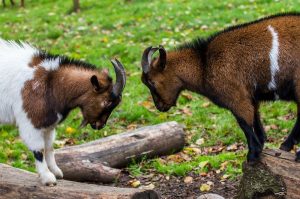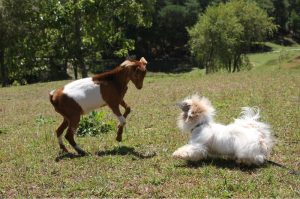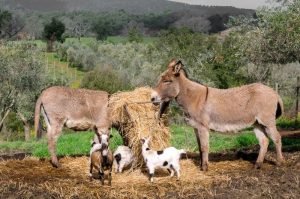
How Do Goats Defend Themselves?
Goats are prey animals, susceptible to several larger natural predators. To survive, they have had to adapt and use all the tools available to protect themselves. If you’ve only seen a goat’s cute and friendly side, you may wonder how they keep themselves safe from predators.
How do goats protect themselves? Goats protect themselves by living in groups and running when a predator approaches them. If cornered, they will use intimidation tactics, including stomping and thrashing. Goats with horns can use them as a last measure of defense. Aside from a goat’s defenses, humans can protect their goats using adequate fencing and livestock guardian animals.
Goats have adapted over the centuries according to their vulnerability. Read on to learn more about the natural predators that goats face, how they defend themselves, and how you can defend them on your property.
How Do Goats Protect Themselves?
Goats may seem like easy pickings, but they are intelligent and resourceful animals, giving them an advantage over predators in an ideal environment. Here are the ways I have seen goats defend themselves:
Goats protect themselves by staying together.
Like most prey animals, goats use to their advantage the fact that there is safety in numbers. To give themselves the greatest chance at success, predators will choose the weakest of the group to attack – these are the youngest or oldest in the herd. A large group of animals packed together makes it much more challenging for a predator to pick out and separate its victim from the rest of the herd. To add to this challenge, many herds will naturally position the weakest individuals in the middle of the stronger animals.
A predator will feel much more confident pursuing and attacking a group of 2-3 goats than a larger herd of 10 or more animals. This is something to keep in mind if you keep goats on your property and have the land and means to keep a larger herd.
Goats protect themselves by running away.
Suppose your goat gets loose and doesn’t want to follow you back to the pen; good luck trying to chase her down. One of the greatest defenses a goat will have is their speed – over the centuries, the fastest and most agile of animals were the ones to survive and procreate, so goats developed the athleticism to keep themselves safe from predators. When faced with a potential threat, the first thing that almost all goats will do is flee. And because they are social animals who feel safe within the herd, the rest will follow when one goat starts running. Unfortunately, this defense will only work if they have the room to run – if your goats are kept in a smaller pen that is penetrable to predators, they will be unable to utilize this most effective of tools.
Goats protect themselves by using intimidation.

When you work with bigger, stronger animals, you must act confident to maintain control – your number one asset is your attitude. Many animals, including goats, will use the facade of strength and confidence to intimidate a threat once cornered. This method works more often than one may assume. When a predator corners its prey and is met with an attitude of confidence, that predator may hesitate, wondering what it is the animal could be so confident about – could it be that this is not as easy a meal as they initially thought? Often the perception of strength will be all a goat needs to run off a predator.
What is it that goats do to intimidate a threat? They may rear back and stomp their feet, lower their heads to show their horns, or thrash about in a way that makes them seem bigger and harder to subdue. They may exhibit all of these behaviors at one time. Often this is all that is needed to cause hesitation in a dog, coyote, or bobcat.
Goats protect themselves with their horns.
Unless polled, goats have their most powerful weapons on their heads – their horns. Depending on the goat breed, some horns are longer and more intimidating than others. Goat horns often grow back away from the head, pointing in the opposite direction of the goat’s eyes. If a goat charges at a predator with these impressive horns atop his head, many threats will turn around and run in the opposite direction – again, the perception of danger is often enough of a deterrent to keep the goat safe.
This is not to say that a goat’s horns are useless in combat. A goat’s skull is incredibly strong, and a head butt has the potential to stun another animal temporarily. Once in close range, a thrashing goat can cause severe damage with his horns and hooves.
Goats headbutt for other reasons other than defending themselves. To learn more about this goat behavior, visit my article Why Do Goats Headbutt? Goat Headbutt Behavior Explained.
How You Can Protect Your Goats
If you have goats on your property, there are a couple of things you can do to significantly reduce or even eliminate the threat of predators to your goats.
Use physical barriers to protect your goats.
Most predators attack at night, so securing your goats in a barn for the evening will protect them against nightly prowlers. In addition to a barn, you should make sure to use adequate fencing to 1) keep your goats on your property and 2) keep predators off of your property. Use fencing at least 5 feet tall, with squares no larger than 4″. Make sure there are no significant gaps and that the fence starts no more than 6″ from the ground. To keep your little escape artists secure and to keep agile predators out, it is wise to utilize electric strands in addition to a secure fence – place one strand at the top of the fence to prevent jumping, one at the bottom to avoid tunneling, and one in the middle to deter goats or other animals from even standing near the fence. These measures should protect your goats from themselves and all but the most persistent of predators.
Use livestock guardians to protect your goats.

One resource used by both modern and ancient farmers alike is livestock guardians. In some countries, it is more common to travel with your herd of goats (or sheep) than to keep secure pens. In these cases, it is up to the shepherd to keep his animals safe. Most shepherds will utilize livestock guardian dogs (LGD breeds) to protect the herd. Common LGDs in the United States include the Great Pyrenees, the Anatolian Shepherd, and the Kuvasz. All LGD breeds are very large and robust – often reaching the size of 100 pounds or more. They are brave and bred to live happily outdoors with the herd 24/7. For this reason, it is not recommended that LGD breeds live as indoor pets. These dogs are incredibly effective at both deterring and chasing off predators.
Dogs are not the only livestock guardians that will protect a herd of goats – instead of LGDs, many farms choose to keep either llamas or donkeys to protect their livestock. Both llamas and donkeys are large and assertive and can be aggressive when needed. They are also very territorial, so while they may or may not feel a protective instinct toward the herd, they will chase off anyone who enters their “territory.”
To learn what kind of livestock guardian best fits your herd, visit my article What Are the Best Livestock Guardian Animals?
What Animals Are the Biggest Threat to Goats?
It might break your heart to think of another animal attacking your goats – but with their smaller statures and stocky, round builds, goats look pretty enticing to larger predators looking for a meal. The predators that may threaten your goats will depend on the region in which you live. In some Northern states, wolves and bobcats may be a problem for your goats. You may need to watch out for mountain lions and bears in other areas. In virtually every region of the United States, coyotes are a threat. And no matter where you live, you may need to watch out for domestic dogs in the neighborhood.
Goats Are Not As Helpless As They May Appear
While goats may appear cute, cuddly, and innocent, they are far from helpless. They have the agility and athleticism to run from predators, the intimidation tactics to use when cornered, and the skulls and horns to make most predators hesitate when charged. Suppose you combine these natural defenses with the security you can (and should) provide, including adequate fencing and the employment of livestock guardians. In that case, most predators will quickly walk in the other direction after deciding your goats are not worth the effort.
How well can goats see their predators? How well can goats see in general? To learn more, visit my article How Goats See: Color Spectrum, Range of Vision & More.
